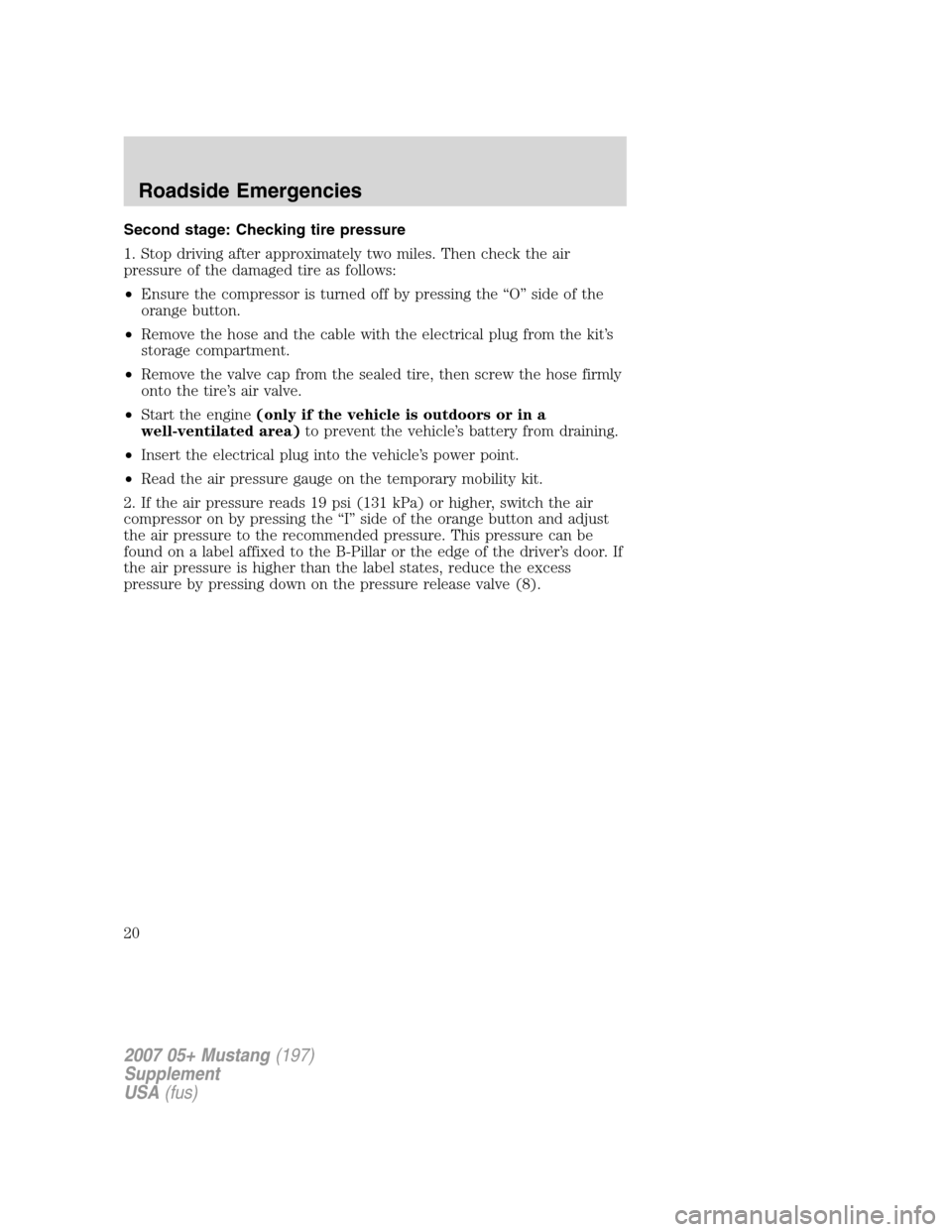Page 20 of 40

Second stage: Checking tire pressure
1. Stop driving after approximately two miles. Then check the air
pressure of the damaged tire as follows:
•Ensure the compressor is turned off by pressing the “O” side of the
orange button.
•Remove the hose and the cable with the electrical plug from the kit’s
storage compartment.
•Remove the valve cap from the sealed tire, then screw the hose firmly
onto the tire’s air valve.
•Start the engine(only if the vehicle is outdoors or in a
well-ventilated area)to prevent the vehicle’s battery from draining.
•Insert the electrical plug into the vehicle’s power point.
•Read the air pressure gauge on the temporary mobility kit.
2. If the air pressure reads 19 psi (131 kPa) or higher, switch the air
compressor on by pressing the “I” side of the orange button and adjust
the air pressure to the recommended pressure. This pressure can be
found on a label affixed to the B-Pillar or the edge of the driver’s door. If
the air pressure is higher than the label states, reduce the excess
pressure by pressing down on the pressure release valve (8).
2007 05+ Mustang(197)
Supplement
USA(fus)
Roadside Emergencies
20
Page 21 of 40

Note:Before driving any further, adjust the tire pressure to the
recommended pressure on the vehicle’s tire placard located on the
B-pillar inside the driver’s door.
3. Turn the air compressor off by pressing the “O” side of the orange
button, then unscrew the hose from the tire’s air valve, reinstall the tire
valve cap, unplug the electrical plug from the power point and stow the
temporary mobility kit in its original location.
What to do after the tire has been sealed
After using the temporary mobility kit to seal your tire, you will need to
replace the sealing compound and hose. Sealing compound and spare
parts can be obtained and replaced at an authorized dealer or tire dealer.
Empty sealing compound bottles may be disposed of at home; however,
liquid residue from the sealing compound should be disposed by your
authorized dealer or tire dealer, or in accordance with local waste
disposal regulations.
Note:After the sealing compound has been used, the maximum vehicle
speed is 50 mph (120 km/h) and the maximum driving distance is
120 miles (200 km). The sealed tire should be replaced immediately, or
at least within the 120 miles (200 km). After sealant use, the TPM (Tire
Pressure Monitoring) sensor located inside the wheel, must be replaced
by an authorized Ford dealer.
2007 05+ Mustang(197)
Supplement
USA(fus)
Roadside Emergencies
21
Page 22 of 40

Note:If you experience any unusual vibration, ride disturbance or noise
while driving, reduce your speed until you can safely pull off to the side
of the road to call for roadside assistance.
You can check the tire pressure any time within the 120 miles (200 km)
by performing the following:
1. Ensure the compressor is turned off by pressing the “O” side of the
orange button.
2. Remove the hose and the cable with the electrical plug from the kit’s
storage compartment.
3. Remove the valve cap from the sealed tire, then screw the hose firmly
onto the tire’s air valve.
4. Insert the electrical plug into the vehicle’s power point.
5. Start the engine(only if the vehicle is outdoors or in a
well-ventilated area)to prevent the vehicle’s battery from draining.
6. Read the air pressure gauge on the temporary mobility kit.
If the tire pressure needs to be increased, operate the air compressor
and inflate the tire to the recommended pressure as indicated on the
label on the B-Pillar or the edge of the driver’s door.
AUXILIARY RELAY BOX
The relay box is located in the engine compartment by the power
distribution box.
8
9
6543217
2007 05+ Mustang(197)
Supplement
USA(fus)
Roadside Emergencies
22
Page 32 of 40

To reduce the risk of personal injury, make sure the engine is
cool before unscrewing the coolant pressure relief cap. The
cooling system is under pressure; steam and hot liquid can come out
forcefully when the cap is loosened slightly.
If you must remove the pressure relief cap or radiator cap (depending
upon engine application), follow these steps to avoid personal injury:
1. Before you remove the cap, turn the engine off and let it cool.
2. When the engine is cool, wrap a thick cloth around the cap. Slowly
turn cap counterclockwise until pressure begins to release.
3. Step back while the pressure releases.
4. When you are sure that all the pressure has been released, use the
cloth to turn it counterclockwise and remove the cap.
Engine coolant refill procedure
The following procedure should be used when refilling the cooling
system after it has been drained or become extremely low.
1. Remove the pressure relief cap from the engine coolant reservoir as
previously outlined.
2. Slowly add a50/50 mixtureof engine coolant and distilled water to
the engine coolant reservoir until the coolant level is at the “cold fill
level” as listed on the reservoir.
3. Reinstall the pressure relief cap.
4. Start and idle the engine until the upper radiator hose is warm (this
indicates the thermostat is open and coolant is flowing through the
entire system).
5. Shut the engine off and let it cool.
6. Remove the pressure relief cap from the engine coolant reservoir as
previously outlined.
7. Add a50/50 mixtureof engine coolant and distilled water to the
engine coolant reservoir until the coolant level is at the “cold fill level” as
listed on the reservoir.
8. Reinstall the pressure relief cap.
9. Check the coolant level in the reservoir before you drive your vehicle
the next few times (with the engine cool).
10. If necessary, add a50/50 mixtureof engine coolant and distilled
water to the engine coolant reservoir until the coolant level is at the
“cold fill level” as listed on the reservoir.
2007 05+ Mustang(197)
Supplement
USA(fus)
Maintenance and Specifications
32